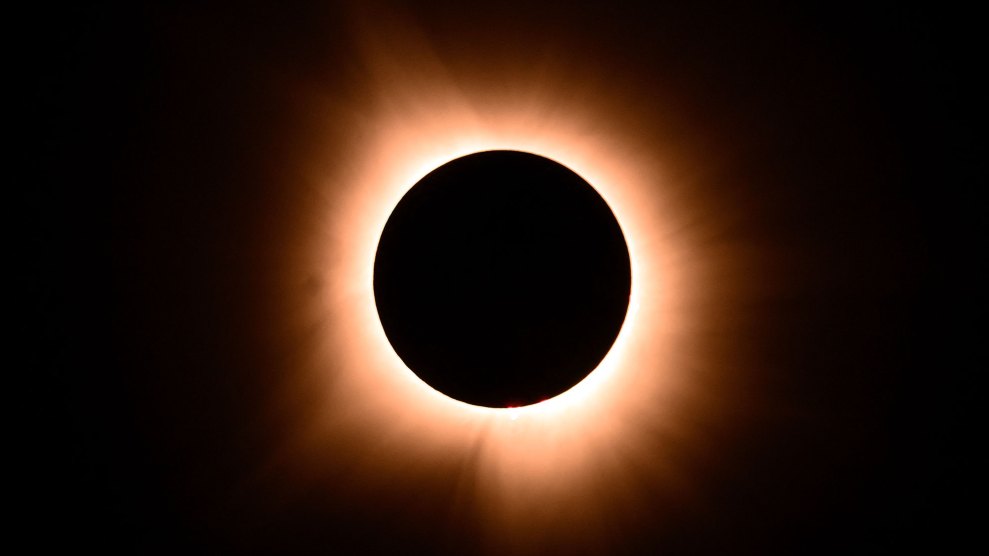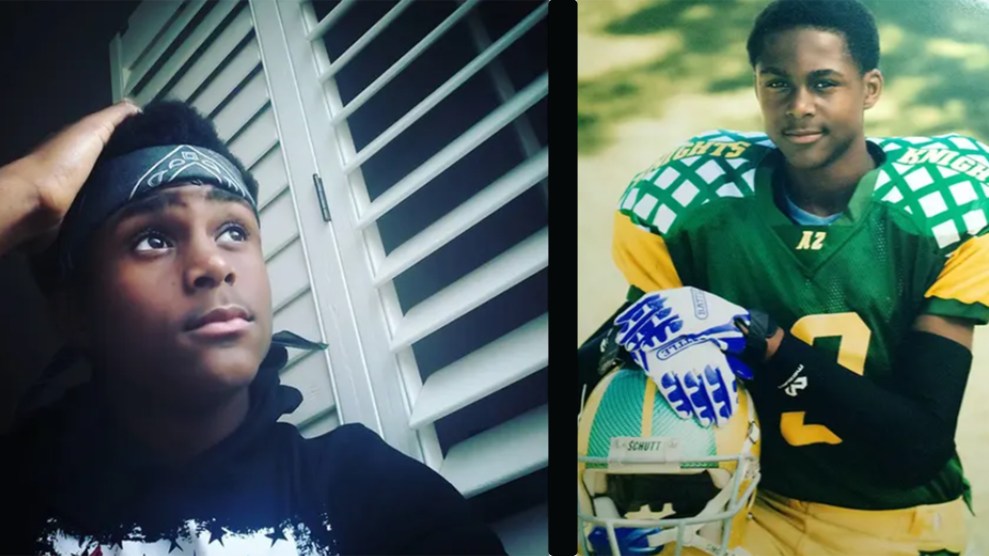
Caleb was an aspiring running back in his better days.Courtesy of the Blair family.
This story was originally published by the Guardian and is reproduced here as part of the Climate Desk collaboration.
Caleb Blair entered the Circle K gas station in Phoenix asking for help. “I can’t breathe, I’m hot, I need to sit down. I can’t breathe,” he told the male cashier. He was sweaty, panting heavily, and struggling to stand up straight.
It was 10 June 2022 in Phoenix, Arizona, and the city was experiencing the season’s first extreme heatwave. The temperature outside was 112F and rising.
The cashier told Caleb, a 19-year-old Black man, that he could not rest inside the air-conditioned store—it was against company policy. Blair had no choice but to go back outside, where CCTV footage shows him curled up on the asphalt, rolling around, distressed and struggling to breathe as cars drive in and out of the parking lot. The temperature on the unshaded ground was probably 130-140F, but the teenager was unhoused and high on fentanyl, a powerful opioid, and methamphetamine, an addictive upper. He was confused, disorientated and overheating.
An hour or so later, a female Circle K employee called 911. “There’s a guy outside, he’s on something,” she said. “He’s banging his head against my car and he’s got blood on the door.”
By then, Caleb was naked and his breathing was worse. The temperature outside had climbed to 115F.
Another 911 caller reported a man in “medical distress…I can see that his foot is cut, he just puked, it looks like it might be blood. He’s been doubled over hitting his head on the ground.” A third caller said: “He’s squatting down between cars, he’s obviously on something, beating the ground…It’s an African American male, he’s got a shoe in his mouth currently, pants around his ankles…He’s pulling his own hair.”
The first police car arrived at 2:56 pm and an officer instructed Caleb to get down on the ground. Seconds later, body-camera footage shows Caleb sitting with his pants around his ankles, knees bent and hands outstretched behind him, in a sort of reverse bridge position. An officer can be heard describing Caleb as “pretty altered,” adding there was “no sign of a weapon.”
More police vehicles arrived on the scene. Caleb did a forward roll on the asphalt, jumped up, and officers grabbed his arms. “We don’t want any trouble, just trying to help you out,” one said.
Caleb was then handcuffed and dragged 25 meters to a shady mesquite tree with his pants still around his ankles. He was sitting bare-legged on the dusty ground covered in thorny leaves, the belt removed from his faded jeans. An officer repeatedly asked his name, but Caleb didn’t respond. The video shows that his breathing was shallow and he could not hold up his head. A couple of minutes later, the paramedics arrived and Caleb seemed unresponsive to light.
At 3:04 pm, officers laid him flat on the ground, removed the handcuffs and pulled up his pants. He did not have a pulse, and at 3:07 pm the paramedics started chest compressions. Caleb was dying. According to Phoenix police, he was transferred to a local hospital where he died from his injuries.
Over the course of eight months, the Guardian interviewed Caleb’s family and teachers, reviewed hours of police body-camera and audio evidence, CCTV footage, and autopsy reports obtained through freedom of information requests, spoke to medical experts and visited places where Caleb had lived and died.
The medical examiner found that Caleb Blair’s death was caused by drug intoxication, with extreme heat and pneumonia identified as contributing factors. (The heat exhaustion or the drugs, maybe both, probably messed with Caleb’s gag reflex, causing him to inhale vomit, resulting in acute pneumonia.)
But after watching the video footage over and over again, Caleb’s father believes that his son died handcuffed on the dusty ground. “My son took his last breath naked, in handcuffs, next to a dumpster,” says Frank Blair, 60. “He was clearly in medical distress but was rolling around outside in the heat before anyone called for help. He didn’t need handcuffs, he needed help. But this is the best a Black man can hope for—people don’t see us.”
Caleb’s death left one family to make sense of losing their sweet, funny boy, but in many ways this was a truly modern American death: the untimely passing of a Black teenager whose potential was cut short by drug addiction, mental illness, homelessness, police contact and the climate crisis.
It raises the question: was Caleb Blair’s death both preventable and inevitable?
When he was a child in Denver, Colorado, one of Frank Blair’s jobs was making sure his younger siblings didn’t get hold of the drugs sold by his violent stepfather—or the pills their mother was addicted to. “Getting the little pills out of the car, and up from between the couch cushions so my siblings didn’t find them, that was my gig,” he says.
Frank left home when he was 12, and promised himself that his own kids would never have to face those issues. He finished high school while living with his grandmother, but couldn’t afford college. Eventually, he started his own business as a contractor and often employed Black ex-prisoners.
In late 2011, Frank moved to Phoenix, Arizona, with his wife, Tywana, and their son Caleb, then nine, as well as two of Frank’s biological daughters, Maile and Kailani, aged eight and nine. (Frank had 12 children, and what he calls a “modern blended family.”)
Caleb’s mother, who declined to speak with the Guardian, had landed a management role with an energy utility, but the move was mostly about escaping what Frank describes as a campaign of racist harassment that landed him in jail and in hospital with severe depression. “If you think that the only way to harm a Black man is to kill him in the street, you’re missing the whole picture. I was a successful Black man giving other Black men a chance. That made me a threat and a target.”
In Phoenix, Frank opened a roadside recovery business and began trading on the stock markets. His new life felt like a fresh start.
His was a tough-love kind of household, but the siblings were close. “[Caleb] would clean our rooms, take the blame if we got in trouble. He was weird and smart and really sweet,” says Kailani, now 20. “He was always building stuff. He had too much energy—it was insane, he would be bouncing off the walls. [Looking back] I’m sure he had ADHD.”
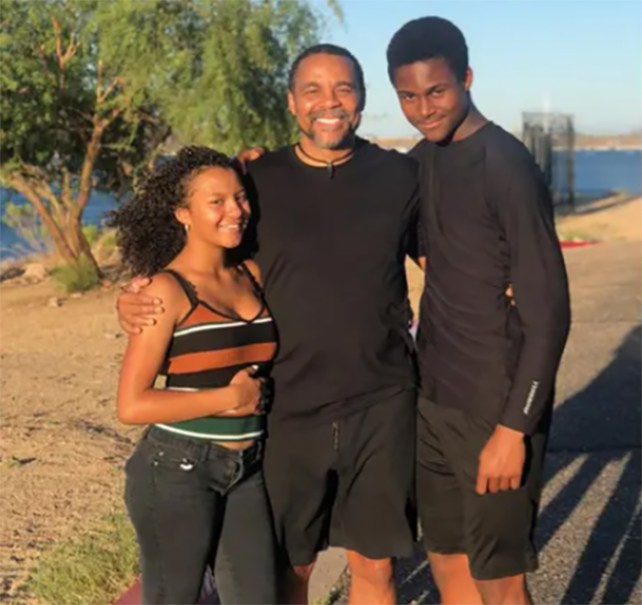
Frank Blair, center, with Caleb and Kailani.
Courtesy of the Blair family.
Kailani remembers the first time Caleb experimented with drugs. He was 11 or 12. He and a friend carved out an apple to smoke weed, and Caleb burned his nose while trying to light up. A year later, Kailani found dozens of bottles of over-the-counter cold medicine and cough syrup containing dextromethorphan (DXM) hidden in his room.
Half of American adolescents have misused drugs at least once, and fatal overdoses, which have more than doubled since 2019, are now the third leading cause of death among teens. Marijuana, nicotine, and alcohol are the most common gateway drugs, but DXM, which in large quantities causes hallucinations and distorts reality, is popular among a significant minority of teens, according to Dr Neeraj Gandotra, chief medical officer at the Substance Abuse and Mental Health Administration.
DXM falls into the class of drugs known as dissociative hallucinogens, which includes ketamine and PCP. It’s illegal to sell DXM products to kids under 18 in some states, including Arizona, but it is popular partly because it’s so easy to steal or buy on the black market.
Kailani told her parents about Caleb’s secret stash of cough medicine bottles. He was grounded, and Frank warned him about the dangers of addiction. They even did random drug tests, but it didn’t stop him. Later, Frank found bottles buried in a box in the garden, along with pieces of aluminum and straws.
Kailani says that at first Caleb just wanted to fit in, to have fun and get high, but things got serious fast. One day, when Caleb was 14, Frank received a call from the principal’s office. Caleb had passed out from a suspected overdose of cough medicine, and an ambulance was on its way. This was not long after Frank had noticed cuts on Caleb’s forearms. He spent two weeks in an adolescent mental health unit, after which he and his parents went to a handful of counselling sessions. Frank and Kailani do not recall a diagnosis.
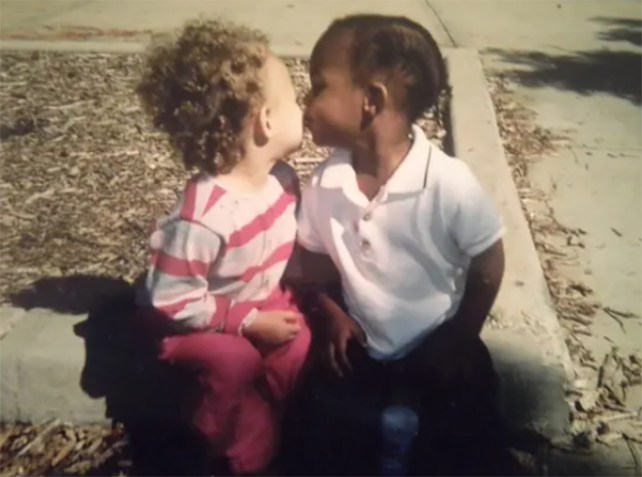
Caleb shares a smooch with one of his sisters.
Courtesy of the Blair family.
A few months later, Caleb overdosed again.“He said the cutting made him feel better, that it calmed him down. Same with the drugs, he liked getting high and it helped slow down his mind. But he couldn’t explain the overdoses. It was a question I asked him many times,” says Frank, who hoped that extra chores and sports would help focus Caleb’s mind and keep him out of trouble.
Caleb was a talented football running back but mostly trained to keep his father happy and joke around with his teammates, according to his football coach, Shawn Kemmer. “The kid had a heart of gold. He would be the first to put his hand up offering to help out. The other kids gravitated towards him. He was highly intelligent, but his brain moved too fast…There was something painful that he couldn’t share, and he stopped showing up. I lost him.”
Caleb got into emo rap and started writing his own lyrics, and the deaths of his two favorite rappers—Lil Peep by suicide and XXXXTentacion by gunshot—hit him hard. Both were just 20. Soon after, Caleb met a girl in high school and together they started abusing Percocet, a prescription painkiller that contains an addictive opioid. At first it was one pill now and again, according to Kailani, but his consumption escalated after getting a part-time job in McDonald’s, which gave him enough money to buy his own regular supply. He was high—or low—all the time. What Kailani remembers most vividly is that he smelled of burning rubber, which came from smoking the Percocet pills.
On some nights, Frank was so scared to lose his son that he would zip-tie his own arm to Caleb’s so that he couldn’t sneak out. But after Caleb got hooked on fentanyl, there was little Frank could do to stop him. He started flunking school and spent more and more time getting high with friends. To this day, Frank is torn about how he handled his son: “Sometimes I think I was too hard on him; sometimes that I should have been tougher,” he says.
Caleb stopped attending school halfway through his freshman year and moved in with his girlfriend’s family, working in fast-food joints and sometimes with Frank, but his drug use spiraled and it all fell apart. “He was sad all the time. For sure he was depressed, it runs in our family. At first he thought the drugs gave him something to rap about, but it took a hold of him,” says Kailani.
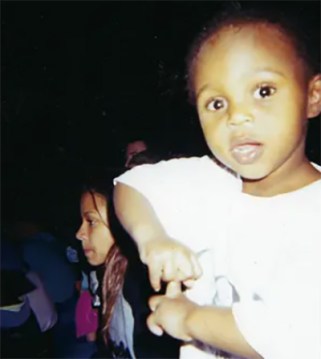
Caleb as a youngster. The family moved to Phoenix when he was nine.
Courtesy of the Blair family
Phoenix is America’s fifth-largest city—and the hottest. The number of perilously hot days and nights is rising thanks to global heating and unchecked urban development. It’s also a city plunged in an affordable housing crisis, where the number of folks sleeping in parks, on sidewalks, behind dumpsters, in parking lots and under bridges has exploded in the past few years.
Heat-related illness and deaths are preventable, but being unsheltered without adequate shade and water increases the risk of exposure and deadly medical complications.
In Maricopa county, where Phoenix is located, more than a thousand people have died from extreme heat in the past three years—about half of them unhoused. Heat exhaustion is characterized by symptoms such as heavy sweating, agitation, confusion, muscle cramps and weakness, and usually occurs when the body temperature hits 104F to 106F. (Normal body temperature is 97F to 99F). Without steps to cool the person down, heat exhaustion can lead to heatstroke—with shortness of breath, vomiting, delirium, and loss of consciousness.
Rates of drug abuse—mostly meth and fentanyl—are also high within Phoenix’s homeless population, and play a role in about half the city’s heat deaths. Meth, a stimulant, can lead to shortness of breath, a rapid heartbeat, sweating and loss of consciousness—symptoms that mimic heat exhaustion and increase the risk of deadly heat exposure. Fentanyl, a synthetic, addictive opioid 50 to 200 times as potent as morphine, is a respiratory downer that can cause very shallow and slow breathing—users have died from heat exposure because they were too out of it to move into the shade.
Heat, homelessness, and drug fatalities are not targeting people in the same measure. In the past decade, drug deaths have almost tripled in the US but have risen almost sevenfold among Black Americans, at least partially due to unequal access to treatment services. In Maricopa county, Black and Indigenous Americans have the highest rate of heat deaths.
Frank knew the risks Caleb faced on the street, and he spent hours every week tracking down his son, bringing him food and water, trying to persuade him to go back into rehab. His regular spots had shade and easy access to food, water and a bathroom, which also attracted dealers peddling meth and fentanyl for a few dollars a hit.
As Caleb’s addiction deepened, his physical state deteriorated. He lost a lot of weight, and his hands and feet were covered in bloody open sores. When Frank could intercept him, he would take Caleb home to shower, cool down, rehydrate and rest, but Caleb wasn’t ready to get clean, so they wouldn’t let him stay.
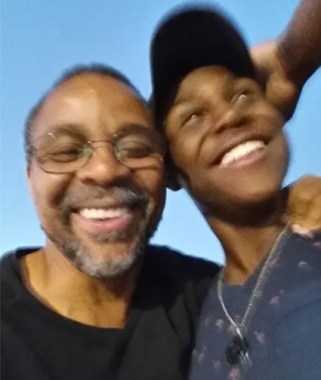
Caleb would say: “’Dad, I’m gonna stop in July or August, I promise.'”
Courtesy of the Blair family
About 50 percent of Americans with a mental health diagnosis are not in treatment, while 90 percent of those with a substance use disorder are in the same boat: in trouble, without professional help. Caleb needed both. “The reasons people don’t enter care are varied and complicated. Payment, access and availability are a large part of it, but it also depends on the individual’s willingness—and families need help so they can help them,” said Gandotra.
In March, Caleb finally agreed to get help and was assessed at a mental health and addiction clinic, but according to Frank, the clinic wouldn’t admit him because he wasn’t suicidal. (The clinic wouldn’t comment on patient care.) He was given thrice-weekly outpatient appointments but didn’t go.
Another time, Frank brought him home and called the police, who took him to a psychiatric clinic. From there, he was transferred to a hospital with severe dehydration and skin infection, and then discharged himself, against psychiatric advice. He told Frank that he wasn’t ready. “He’d say ‘Dad, I’m gonna stop in July or August, I promise.’ But in my head I knew we weren’t gonna make it to August.”
By then, Caleb’s relationship with his mother had broken down completely, and the hours Frank spent tracking down his son were causing friction in their marriage. He was barely sleeping, and his children worried about the impact on his mental health.
Still, he couldn’t give up on Caleb.
In the final months of his life, Caleb often slept on a dusty waste ground behind a Family Dollar store, where he had pitched his tent alongside dozens of other unhoused people. A helper by nature, he had constructed a makeshift communal washroom using a tree and some tarpaulin.
On May 10, he was in a bad way but still talking about quitting when Frank took him for Mexican food and gave him a new mobile phone. The next day Caleb, who had outstanding misdemeanors for petty theft, was arrested for having missed a court date. Caleb called Kailani and his dad from jail, asking them to pay the $100 bond. But they both felt relieved that he was off the streets and refused to help him get out, hoping that he would dry out.
Caleb was released four weeks later, on June 8. His drug tolerance was probably lower, and the National Weather Service had issued the year’s first extreme heat advisory. Frank had intended to pick him up, but got caught up with work and didn’t go. Later he drove to Caleb’s regular spots, but couldn’t find him. “I knew he was vulnerable coming out of jail, but I kept working, and time just passed until it was too late. I dropped the ball.”
Kailani had arranged to take Caleb for dinner on the 9th, but he didn’t show up. “On our last call, he’d told me that he wanted to have some fun when he got out, but after that he was going to give it up, get his GED, get a job. He was tired of street life, said he wanted what I have,” says Kailani, who was living with her partner and pregnant at the time.
The following day, Kailani drove past the Circle K and saw a bunch of police vehicles and paramedics, but had no idea who was in trouble. A few hours later, police officers knocked on Frank’s door.
“I never imagined that my sweet, funny little brother would end up a dead drug addict. I honestly thought he’d figure it out, stop being addicted and move on with his life,” Kailani says. “The homeless crackheads you walk past on the street, they are people like my brother. This can happen to anybody.”
We now know that at the hospital, after having spent several hours in the baking heat, Caleb’s temp was 109F. The paramedics’ thermometer maxes out at 108F, after which it simply reads “high.”
Six months later, Frank still spends several hours a week visiting Caleb’s old spots, unable to give up the grueling routine. Sometimes, he parks his truck next to the tree where Caleb lost consciousness. Caleb’s death makes no sense, and yet perfect sense.
“This is a silent epidemic. I want people talking about it, so that something good comes out of it. I feel like a failure but I don’t want my son’s death to be for nothing. That’s how I’m dealing with my grief.”



